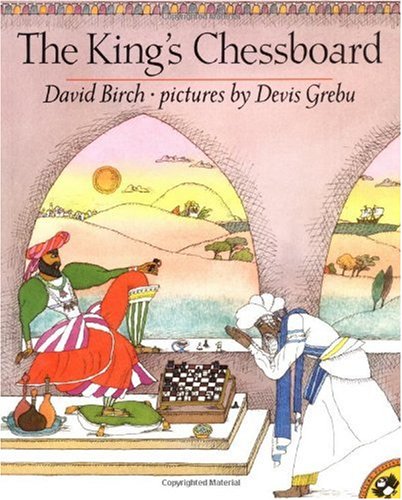
I began class today by reading a story called The King's Chessboard by David Birch. I found this activity years ago in the book, Math and Literature (Grades 4-6) by Rusty Bresser.
The story tells of a king who insists on rewarding a wise man and in the process is taught a lesson on both humility and mathematics. Basically, the king agrees to give the wise man one grain of rice, doubled daily, for 64 days. As soon as I read the reward, my kids knew the king was in trouble! All of them recognized this reward as being the same as the "Million Dollar Dilemma" we solved on Monday. They were interested to see how the story played out knowing that doubling numbers increases them very quickly.
Before moving into the math problem for the day, I had the kids transfer the data from "Million Dollar Dilemma" onto a chart, explaining that we were going to need to know how many grains of rice were delivered each day. Once we had the chart complete (which took very little time as we had done the math Monday), I posed the question:
On which day would enough grains of rice be
sent to feed our 5th grade?
I asked the classes how we would solve this problem. What do we need to know? They all agreed that the first thing we need to know is the number of 5th graders (56). Then we needed to know how much rice a 5th grader could eat (1/2 cup). Next, how many grains of rice are in a 1/2 cup?
At this point, it was time to estimate. I gave each group 1/2 cup of rice and a teaspoon. I asked how we could use these items to determine the number of grains of rice in 1/2 cup. First they wanted to find out the number of teaspoons in 1/2 cup (the average was slightly different for each class). Then they wanted to know how many grains were in a teaspoon (again, the averages were slightly different for each class).
Once we had this knowledge we could determine the approximate number of grains in 1/2 cup by using multiplication. Then we were able to use this product to determine the number of grains of rice needed for 56 fifth graders, again by multiplying. Using this final product, we were able to determine which day enough grains were sent (Day 20).
However, I posed another question.... Is 1/2 cup of uncooked rice the same as 1/2 cup of cooked rice. Someone in each class invariably knew that rice expands. So, knowing that rice expands to 3x its size when cooked, the kids decided that we needed to take our product and divide by 3. This provided us with the answer to our original question.
Here are examples of each class's work:
Johnson:
Dittrich
Whitehead
HOMEWORK: Countdown 7.3


No comments:
Post a Comment